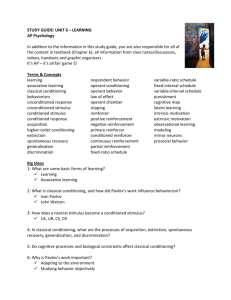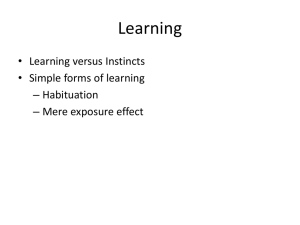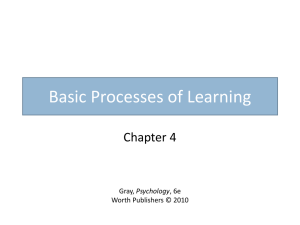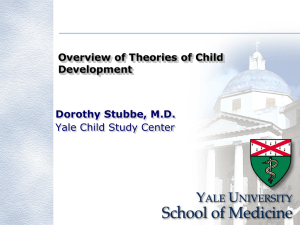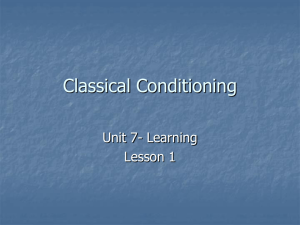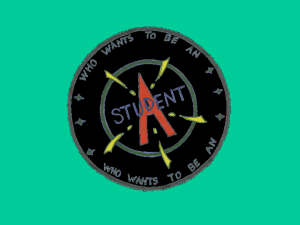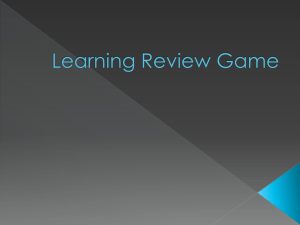Chpt8Learning
advertisement
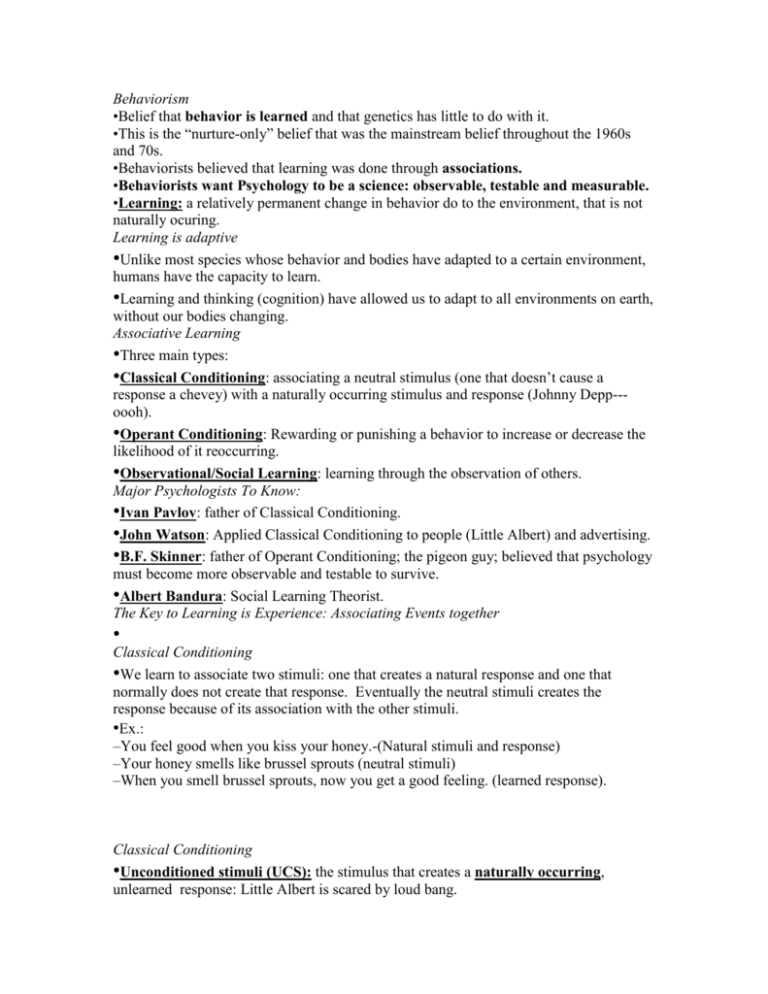
Behaviorism •Belief that behavior is learned and that genetics has little to do with it. •This is the “nurture-only” belief that was the mainstream belief throughout the 1960s and 70s. •Behaviorists believed that learning was done through associations. •Behaviorists want Psychology to be a science: observable, testable and measurable. •Learning: a relatively permanent change in behavior do to the environment, that is not naturally ocuring. Learning is adaptive •Unlike most species whose behavior and bodies have adapted to a certain environment, humans have the capacity to learn. •Learning and thinking (cognition) have allowed us to adapt to all environments on earth, without our bodies changing. Associative Learning •Three main types: •Classical Conditioning: associating a neutral stimulus (one that doesn’t cause a response a chevey) with a naturally occurring stimulus and response (Johnny Depp--oooh). •Operant Conditioning: Rewarding or punishing a behavior to increase or decrease the likelihood of it reoccurring. •Observational/Social Learning: learning through the observation of others. Major Psychologists To Know: •Ivan Pavlov: father of Classical Conditioning. •John Watson: Applied Classical Conditioning to people (Little Albert) and advertising. •B.F. Skinner: father of Operant Conditioning; the pigeon guy; believed that psychology must become more observable and testable to survive. •Albert Bandura: Social Learning Theorist. The Key to Learning is Experience: Associating Events together • Classical Conditioning •We learn to associate two stimuli: one that creates a natural response and one that normally does not create that response. Eventually the neutral stimuli creates the response because of its association with the other stimuli. •Ex.: –You feel good when you kiss your honey.-(Natural stimuli and response) –Your honey smells like brussel sprouts (neutral stimuli) –When you smell brussel sprouts, now you get a good feeling. (learned response). Classical Conditioning •Unconditioned stimuli (UCS): the stimulus that creates a naturally occurring, unlearned response: Little Albert is scared by loud bang. •Unconditioned Response (CR): ALWAYS a naturally, physiological/psychological response. Disgust, Pleasure, fear: NEVER A CHOSEN ACTION, Classical Conditioning •Neutral Stimuli: anything that does not naturally create the unconditioned response (the rat). •Conditioned Stimuli (CS): when the neutral stimuli creates the same response (CR) as the unconditioned stimuli (UCS), which is, then, the Conditioned Stimulus (CS). So, the CS is always the same as the neutral. the Rat in Little Albert. Classical Conditioning •Conditioned Response (CR): the response to the CS. Crying as response to Fear. •ALWAYS a naturally, physiological/psychological response. Disgust, Pleasure, fear: NEVER A CHOSEN ACTION, Example of Classical Conditioning •Little Albert. •Pavlov’s Dogs. •Johnny Depp (Angolina Jolie) walks in their underwear holding hemorrhoid cream, repeatedly. Hemorrhoid cream is HOT> Example of Classical Conditioning •UCS: Depp or Jolie •UCR: OOOOHHHHHH (arousal) •Neutral: Cream •CS: Cream •CR: OOOOOHHHHH (arousal) Ivan Pavlov •Father of Classical Conditioning. •Doing experiments on dog digestion: Noticed that whenever his assistant, who fed the dogs, would come into the room, the dogs would salivate, even if he wasn’t carrying food. What’s the UCS, UCR, Neutral, CS, CR? Let’s see if you got it… Classical Conditioning: Pavlov’s Dog •UCS=Food •UCR=Salivation •NS=Attendant’s footsteps •CS=Attendant’s footsteps •CR=Salivation Note: Pavlov then did an experiment using tones to classically condition the dog…can you explain the UCS, UCR, NS, CS, & CR? Classical Conditioning: Pavlov’s Dog •NS=Tone Meth use •UCS=Food Graphic image •UCR=Salivation Disgust •CS=Tone •CR=Salivation Meth use Disgust Acquisition: acquiring the CS/CR •For the neutral to become a CS: The neutral must precede the UCS by a short interval. (varies with cognitive level of species). The snap of a twig makes you afraid that a predator might be near. But if your experience was that the twig snaps come after the attack, or two hours before, it is unlikely association would occur. Extinction and Spontaneous Recovery •When the neutral stimuli is no longer coupled with the UCS several times: extinction, or the ending of the CR occurs. (Your funny little honey no longer smells of Brussel sprouts). •However, after a rest pause when extinction has occurred, the CR may reoccur spontaneously-called Spontaneous Recovery. (two weeks later you smell Brussel Sprouts and you feel good again). Generalization and Discrimination •When a CS is generalized to other similar stimulus: Let’s say you are bitten by a Pit Bull (whose owner is in denial and says her dog isn’t vicious). Now you become afraid of all dogs, that’s generalization. •But after experiencing many dogs, you learn that Labradors won’t bite, so you’re afraid of Pit Bulls, but not Labs. That’s discrimination. Cognitive Affects •Sometimes thinking can overcome the affects of Classical Conditioning. Thus, if you put something in alcohol that makes a drinker sick and they know it, they will not be conditioned to avoid alcohol, only alcohol laced with the substance that makes them sick. Biological Predispositions •It is easier to associate some stimuli than others. For instance, if you see a spider and dad screams, you might develop a classically-conditioned phobia right away. •Garcia famous experiment: rats become conditioned immediately to anything that makes them sick, particularly Tastes, but not shapes. •Human’s naturally fear snakes, spiders, swooping birds, easy to condition, roses, shapes much more difficult. Classical Conditioning Review •Tactless Tom yells at Emotional Ernie. As a Result, Ernie’s blood pressure rises.The next time Ernie sees Tom, Ernie’s blood pressure rises. (N)________ + (UCS)_________ (UCR) _______ (CS) ___________ (CR) _________ •Two practical jokers want to get a horse to involuntarily go wild (op def: the horse’s heart races) every time the horse hears “whoa.” The jokers will kick the horse in order to train him. (N)________ + (UCS)_________ (UCR) _______ (CS) ___________ (CR) _________ •The same practical jokers want to make a dog afraid of a cat by shocking the dog every time he sees a cat. (N)________ + (UCS)_________ (UCR) _______ (CS) ___________ (CR) _________ •As a child, Joni’s mother would ring a bell every time she gave Joni medicine. The medicine naturally produced an upset stomach. Now, every time Joni hears a bell, her stomach becomes queasy and upset. (N)________ + (UCS)_________ (UCR) _______ (CS) ___________ (CR) _________ Operant Conditioning •In Operant conditioning we learn to associate a behavior with its consequence. We are then more or less likely to repeat the behavior, depending on the consequence. •You put your hand in a fire, you get burned, you don’t put your hand in the fire. •You put candy in your mouth, it tastes good, you put more candy in your mouth. Important Concept •Reinforcers Always encourage/increase behavior/responses. •Punishments ALWAYS inhibit/discourage/ decrease responses Reinforcers •Positive: rewards strengthen a behavior, encourage it to repeat. •Negative reinforcement: you do something to make something bad stop or avoid something bad. You take out the garbage so you don’t get grounded. Types of Reinforcements •Reinforcements may be tangible, praise or being allowed to do something, any consequence that strengthens a behavior. Primary vs. Secondary •Primary reinforcers are any reinforcements that act innate (born with) desire. Food, parental praise, sexual arousal. •Secondary reinforcers (conditioned reinforcers) are learned and often represent primary reinforcers. Getting an A on a test, represents praise and a self-esteem boost (learned). Immediate vs. Delayed •The more immediate the reinforcement the more powerful. Sometimes small but immediate reinforcers can be more powerful the large delayed ones. For instance, unprotected sex, alcohol and drugs. •Delayed gratification: children who can delay gratification tend to be the most successful , socially competent adults. Schedules of Reinforcement •Continuous reinforcement: getting reinforced every time helps you learn a behavior quickly, but extinguishes quickly if the reinforcement stops. (Think how quickly you’d stop studying if no grades were to be given, ever). •Partial reinforcement (intermittent): learning is slower, but extinguishes slower as well. Schedules of Reinforcement •Fixed Ratio: Reinforcement is given after a specific number of behaviors. You get a test grade of an A for every five article reviews you turn in. Encourages speedy repetition of behavior. •Variable Ratio: reinforcement occurs after an unpredictable number of behaviors. Slot machines. High rates of responding too. Schedules of Reinforcement •Fixed Intervals: Reinforcements occurs after a specific length of time goes by. Working for a pay check. Encourages slow methodical work. Behavior increases in speed as reinforcement time approaches--students at the end of the quarter. •Variable Interval: Reinforcement occurs at an unpredictable time. (Fishing) Slow steady responses. •Trick: Try using the word watching or waiting, if it works, it’s probably interval. •If the REWARD or Punishment comes from doing it’s ratio, if it comes from waiting it Interval. •Pd 10 dollars for every 20 puzzles solved. •Study for a class that has surprise quizzes. •Slot machines based on this. •Trolling for fish in a lake •Speed traps •Selling products door to door. •Getting clothes from dryer after buzzes. •Going up a staircase to reach a landing with a nice view •Pd 10 dollars for every 20 puzzles solved. FR. •Study for a class that has surprise quizzes. VI •Slot machines based on this. VR •Trolling for fish in a lake VI •Speed traps VI •Selling products door to door. VR •Getting clothes from dryer after buzzes. FI •Going up a staircase to reach a landing with a nice view FR •Doing 20 pushups to stay fit. •Playing Bingo •Getting a paycheck at the end of 2 weeks •Random drug testing •A strike in bowling •Calling your mechanic to see if car is fixed Frequent flyer miles where one gets free flight after a specific number of miles flown. •Doing 20 pushups to stay fit. FR •Playing Bingo FR •Getting a paycheck at the end of 2 weeks FI •Random drug testing VI •A strike in bowling VR •Calling your mechanic to see if car is fixed VI •Frequent flyer miles where one gets free flight after a specific number of miles flown. FR •Child screams and cries in store to get what she wants –every so often it works. •Child who like to hear the theme from Jeopardy every night at 7. •Trying to find a parking meter that works. •Wife is watching boxing match with husband-receives kiss at the end of every round. •Waiting for a sunny day to go to beach. •Surfer waiting for perfect wave. •Looking under rocks for worms. •Child screams and cries in store to get what she wants –every so often it works. VR •Child who like to hear the theme from Jeopardy every night at 7. FI •Trying to find a parking meter that works. VR •Wife is watching boxing match with husband-receives kiss at the end of every round. FI •Waiting for a sunny day to go to beach. VI •Surfer waiting for perfect wave. VI •Looking under rocks for worms.FR Punishment •Punishment makes you stop doing a behavior, the opposite of a reinforcement. •Immediate and sure punishment can powerfully diminish a behavior. •However, if punishment is avoidable, the behavior will reemerge, implying that it has been suppressed not extinguished. Punishment •Receivers of punishment may associate the punisher with the punishment, and not the behavior. So, a child who is hit may not associate the beating with the behavior, but with the parent, causing them to fear the parent. (classical conditioning). •Children who are hit may learn through observation (social learning) that aggression is an acceptable problem solving technique. Shaping •Complex behaviors are usually learned in “baby steps.” Successive approximations of a behavior are reinforced until the more complex behavior is achieved. This process is called shaping. If you want your dog to play dead, teach him to stay, then sit, then lay down, then roll over and then roll over and stay. Punishment •Learned helplessness: If punishment is unpredictable and inescapable, subjects may just give up. Dogs who are tethered and shocked at varying intervals will eventually not even try to escape when let off the leash. Used to explain why, perhaps, battered women will stay with an abusive husband. Cognition and learning •Current studies have shown that animals sometimes learn without reinforcement, they just don’t exhibit the learning until there is a reinforcement available. Rats who have been exposed to a maze, but have not run it, run through it faster than rats who have not been exposed to the maze, when a reward is at the end, implying they learned the maze earlier. This is called latent learning. Cognition and learning •Overjustification effect: Animals who will intrinsically do a behavior they enjoy and then are reinforced for doing it, may stop doing the behavior unless the reward follows. People are the same—if children are rewarded for a task they already enjoy doing, they may begin to see the reward as their motive, losing their intrinsic motivation. Token Economies •Used in schools, rehab clinics and detention/jail enviornments, to encourage appropriate behaviors. •People are given immediate rewards for desired behaviors: gold stars, grades, money, 12 step programs, extra visit homes etc. Biological Predisposition •It is easier to teach an animal to do something that is similar to innate behavior than something that is not. Differences between Operant and Classical Conditioning •First, think of responses as coming from subject and stimuli outside sources. •In Classical Conditioning the stimuli is “done” to the subject without any behavior necessary (involuntary). In Operant, the subject does something (voluntary) and the response is reinforced by the stimuli. Classical or Operant Conditioning? Shaping, extinction, discrimination, generalization? •John Nasalpassages walks into his first period history class. His adrenaline starts flowing because he has to take a test and he failed the last one. •When he flunked the last test, John used an old pencil, so this time he pulls out a new pencil. Classical or Operant Conditioning? Shaping, extinction, discrimination, generalization? •John Nasalpassages walks into his first period history class. His adrenaline starts flowing because he has to take a test and he failed the last one. Classical conditioning •When he flunked the last test, John used an old pencil, so this time he pulls out a new pencil. Operant, generalizing. Classical or Operant Conditioning? Shaping, extinction, discrimination, generalization? •John does not ask Mr. Rondo any questions during the test because Mr. Rondo ridiculed him last time he asked a question. •Every time John sees someone who resembles Mr. Rondo he starts to sweat uncontrollably. •Mr. Tinker looks like Mr. Rondo, and John sweats at first. But every day Mr. Tinker encourages John to participate, and eventually John does raise his hand in Mr. Tinker’s class. Classical or Operant Conditioning? Shaping, extinction, discrimination, generalization? •John does not ask Mr. Rondo any questions during the test because Mr. Rondo ridiculed him last time he asked a question. Operant Cond •Ever€y time John sees someone who resembles Mr. Rondo he starts to sweat uncontrollably. CC, generalization •Mr. Tinker looks like Mr. Rondo, and John sweats at first. But every day Mr. Tinker encourages John to participate, and eventually John does raise his hand in Mr. Tinker’s class. Operant, Shaping Classical or Operant Conditioning? Shaping, extinction, discrimination, generalization? •And he stops sweating in Tinker’s class. •After John’s test, blond Tina talks with him and smiles. John’s blood pressure rises. In his next class he talks with another blond, Imelda, and his blood pressure rises. •Imelda, however, is rude to John. So, eventually, his blood pressure rises when Tina talks with him, but not when Imelda does. Classical or Operant Conditioning? Shaping, extinction, discrimination, generalization? •And he stops sweating in Tinker’s class. classical and extinction. •After John’s test, blond Tina talks with him and smiles. John’s blood pressure rises. In his next class he talks with another blond, Imelda, and his blood pressure rises. Classical and generalization. •Imelda, however, is rude to John. So, eventually, his blood pressure rises when Tina talks with him, but not when Imelda does. Classical and discrimination •CC --> Stimuli then Response. Food--Salivation. •Operant-->Response then stimuli (consequence/reinforcement). Hand goes to fire (voluntary response) --->Burned (stimuli). Social Learning Theory •Learning also takes place through observation and imitation of others, without reinforcement. This is called modeling. •Albert Bandura is credited with this theory. •Children who observe violence on television from the hero, tend to act more aggressively immediately afterward. Social Learning Theory •Children do as they see, not as they’re told. •Children will be most imitative of behaviors they see consistently. When exposed to hypocrisy, they act hypocritically. Memes •Are units of culture that passed from mind to mind. •These memes allow for human culture to change and evolve. •Memes are made possible by our ability to observe and imitate behavior. The meme once imitated is rewarded or punished on whether or not it benefits the imitator. The reward or punishment is classically conditioned by the feelings one receives from imitating it. (dopamine bursts) MEMES •Can be language, styles, technology, religion, beliefs, anything that determines human cultures or sub-cultures. •“Da bomb”, low-rider jeans, ipods, eight tracks, democracy, “stuntin”, platform shoes, long-hair, baggy pants, zoot suits, what is considered pretty, hair styles, cell phones, “sweet,” bell-bottoms, cigarette smoking, health consciousness, “whale tails”…anything. •All are seen or heard, imitated, and then discarded or continued. In conclusion •In the real world, these learning phenomena generally work together. An unconditioned response may have been learned operantly or observationally, previously, and are then associated with a neutral stimuli (CC). You learn (operantly or observationally) that “A”s get positively reinforced, which represents love from parents. You then associate a teacher or subject(N) with “A”s (CC), and respond favorably to the teacher or subject.


